Evaluating Impact of Training & Development on Employee Performance
VerifiedAdded on 2023/05/30
|10
|2182
|348
Project
AI Summary
This project investigates the impact of employee training and development programs on overall job performance. It outlines the background, aims, objectives, and expected outcomes of the study, focusing on how training influences employee activity and identifies factors that enhance performance post-training. The research design employs a descriptive approach, utilizing secondary data collected from academic journals and business reports. Data analysis involves qualitative methods, thematic analysis, and tools like Microsoft Excel and SPSS. The project includes a timeline, risk management strategies, and ethical considerations to ensure research integrity. Ultimately, the study aims to highlight the importance of training in improving employee performance and pinpoint areas for development in the training process, offering valuable insights for organizations seeking to optimize their training initiatives. Desklib provides access to similar solved assignments and study resources for students.
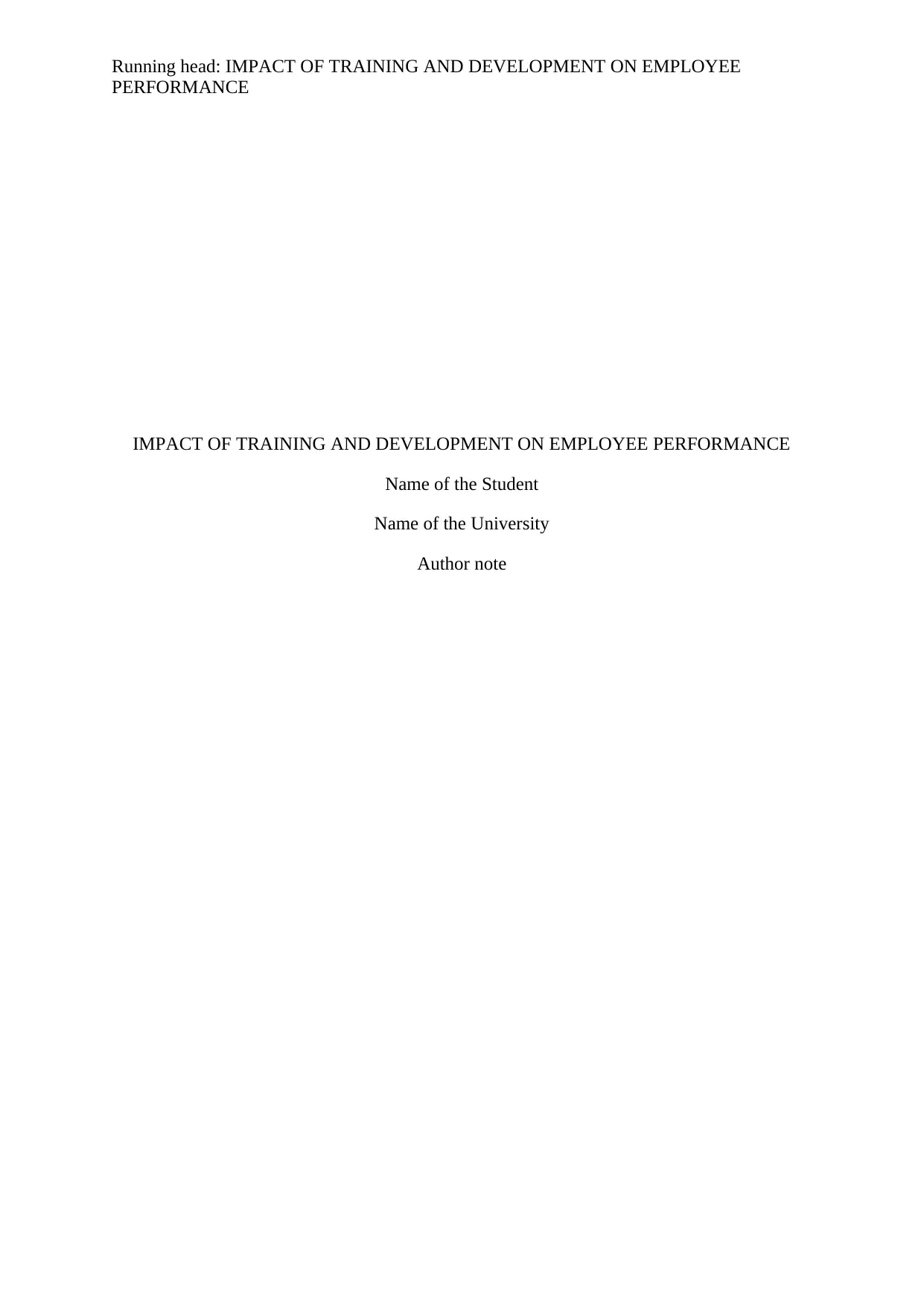
Running head: IMPACT OF TRAINING AND DEVELOPMENT ON EMPLOYEE
PERFORMANCE
IMPACT OF TRAINING AND DEVELOPMENT ON EMPLOYEE PERFORMANCE
Name of the Student
Name of the University
Author note
PERFORMANCE
IMPACT OF TRAINING AND DEVELOPMENT ON EMPLOYEE PERFORMANCE
Name of the Student
Name of the University
Author note
Paraphrase This Document
Need a fresh take? Get an instant paraphrase of this document with our AI Paraphraser
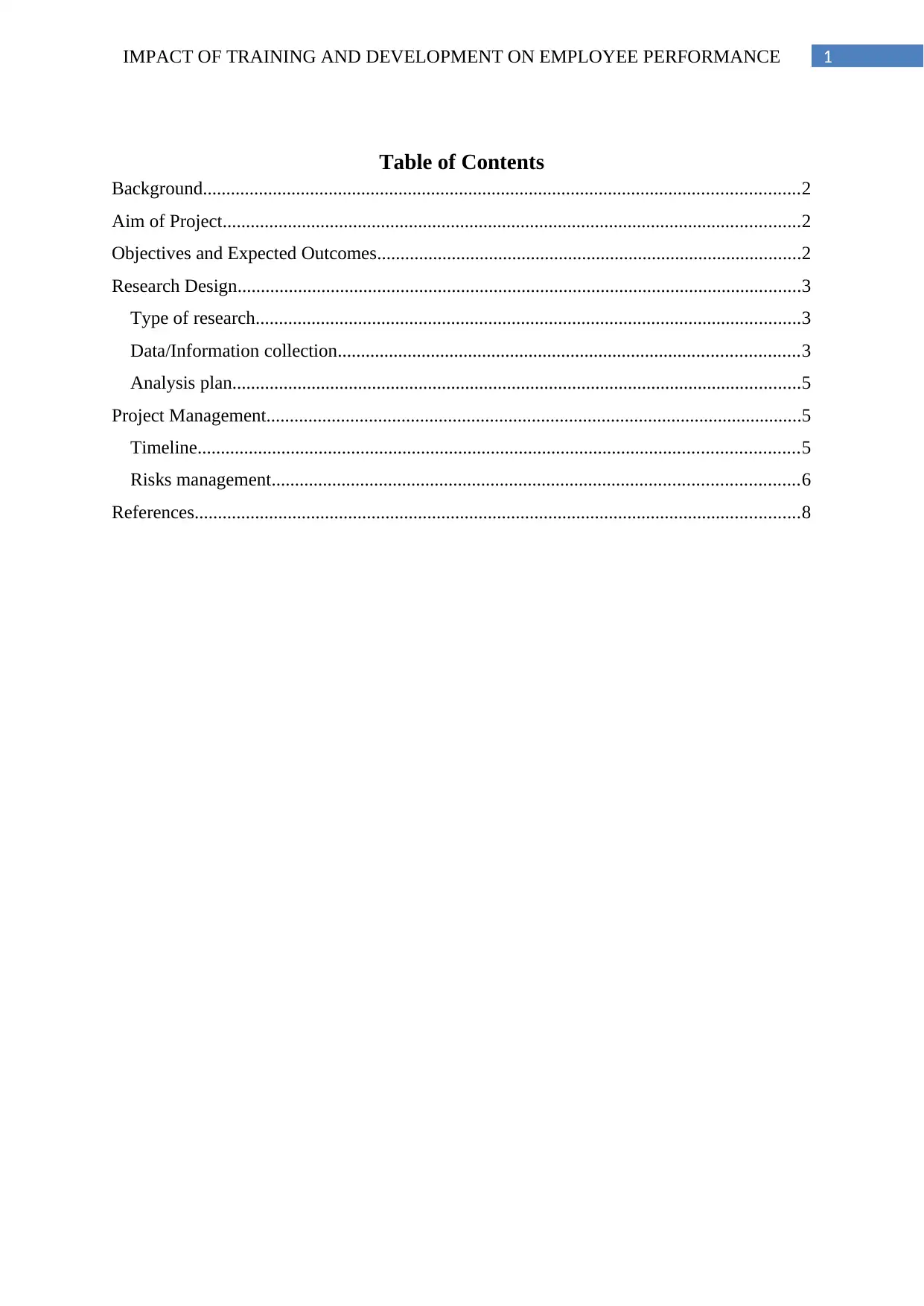
1IMPACT OF TRAINING AND DEVELOPMENT ON EMPLOYEE PERFORMANCE
Table of Contents
Background................................................................................................................................2
Aim of Project............................................................................................................................2
Objectives and Expected Outcomes...........................................................................................2
Research Design.........................................................................................................................3
Type of research.....................................................................................................................3
Data/Information collection...................................................................................................3
Analysis plan..........................................................................................................................5
Project Management...................................................................................................................5
Timeline.................................................................................................................................5
Risks management.................................................................................................................6
References..................................................................................................................................8
Table of Contents
Background................................................................................................................................2
Aim of Project............................................................................................................................2
Objectives and Expected Outcomes...........................................................................................2
Research Design.........................................................................................................................3
Type of research.....................................................................................................................3
Data/Information collection...................................................................................................3
Analysis plan..........................................................................................................................5
Project Management...................................................................................................................5
Timeline.................................................................................................................................5
Risks management.................................................................................................................6
References..................................................................................................................................8
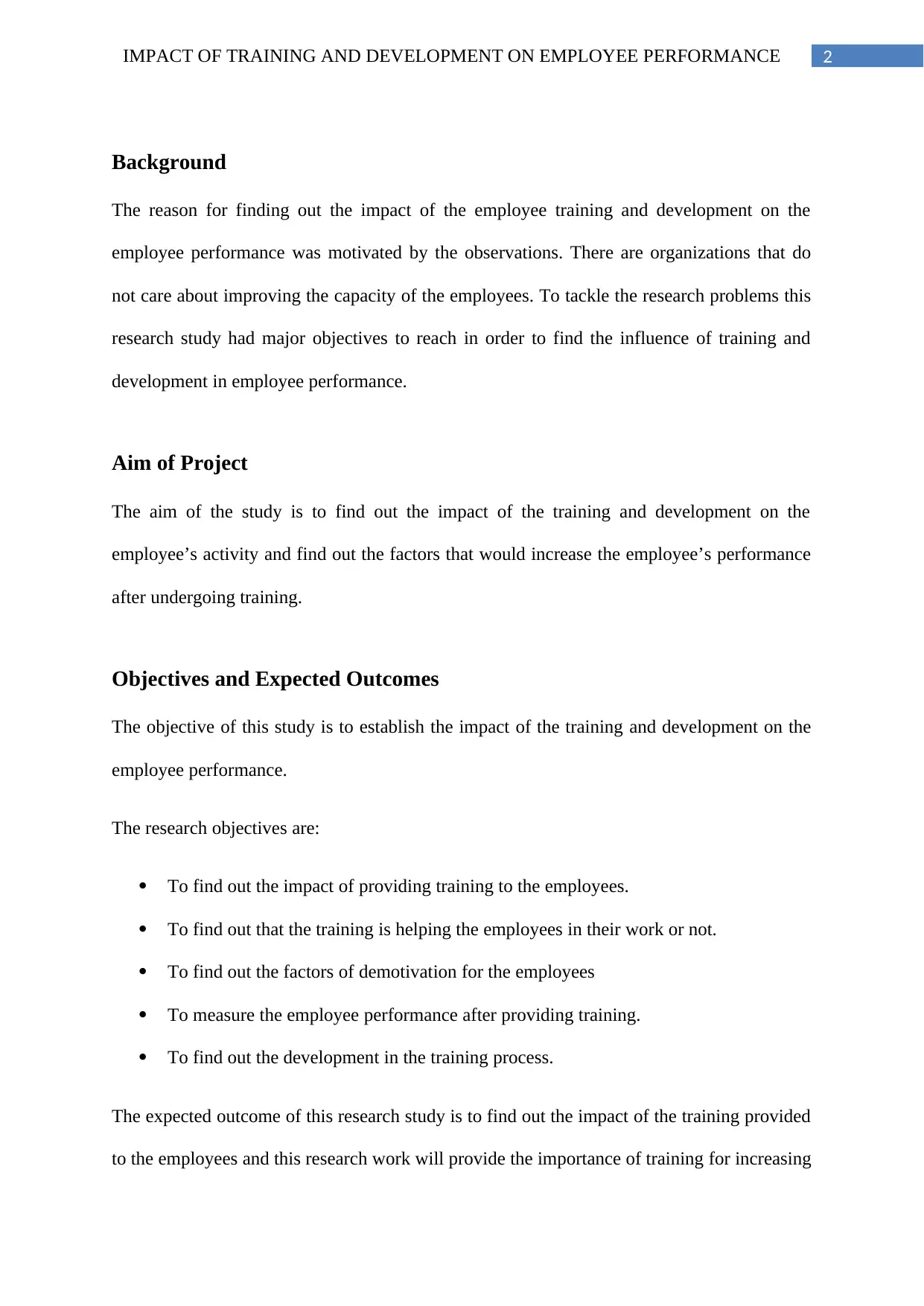
2IMPACT OF TRAINING AND DEVELOPMENT ON EMPLOYEE PERFORMANCE
Background
The reason for finding out the impact of the employee training and development on the
employee performance was motivated by the observations. There are organizations that do
not care about improving the capacity of the employees. To tackle the research problems this
research study had major objectives to reach in order to find the influence of training and
development in employee performance.
Aim of Project
The aim of the study is to find out the impact of the training and development on the
employee’s activity and find out the factors that would increase the employee’s performance
after undergoing training.
Objectives and Expected Outcomes
The objective of this study is to establish the impact of the training and development on the
employee performance.
The research objectives are:
To find out the impact of providing training to the employees.
To find out that the training is helping the employees in their work or not.
To find out the factors of demotivation for the employees
To measure the employee performance after providing training.
To find out the development in the training process.
The expected outcome of this research study is to find out the impact of the training provided
to the employees and this research work will provide the importance of training for increasing
Background
The reason for finding out the impact of the employee training and development on the
employee performance was motivated by the observations. There are organizations that do
not care about improving the capacity of the employees. To tackle the research problems this
research study had major objectives to reach in order to find the influence of training and
development in employee performance.
Aim of Project
The aim of the study is to find out the impact of the training and development on the
employee’s activity and find out the factors that would increase the employee’s performance
after undergoing training.
Objectives and Expected Outcomes
The objective of this study is to establish the impact of the training and development on the
employee performance.
The research objectives are:
To find out the impact of providing training to the employees.
To find out that the training is helping the employees in their work or not.
To find out the factors of demotivation for the employees
To measure the employee performance after providing training.
To find out the development in the training process.
The expected outcome of this research study is to find out the impact of the training provided
to the employees and this research work will provide the importance of training for increasing
⊘ This is a preview!⊘
Do you want full access?
Subscribe today to unlock all pages.

Trusted by 1+ million students worldwide
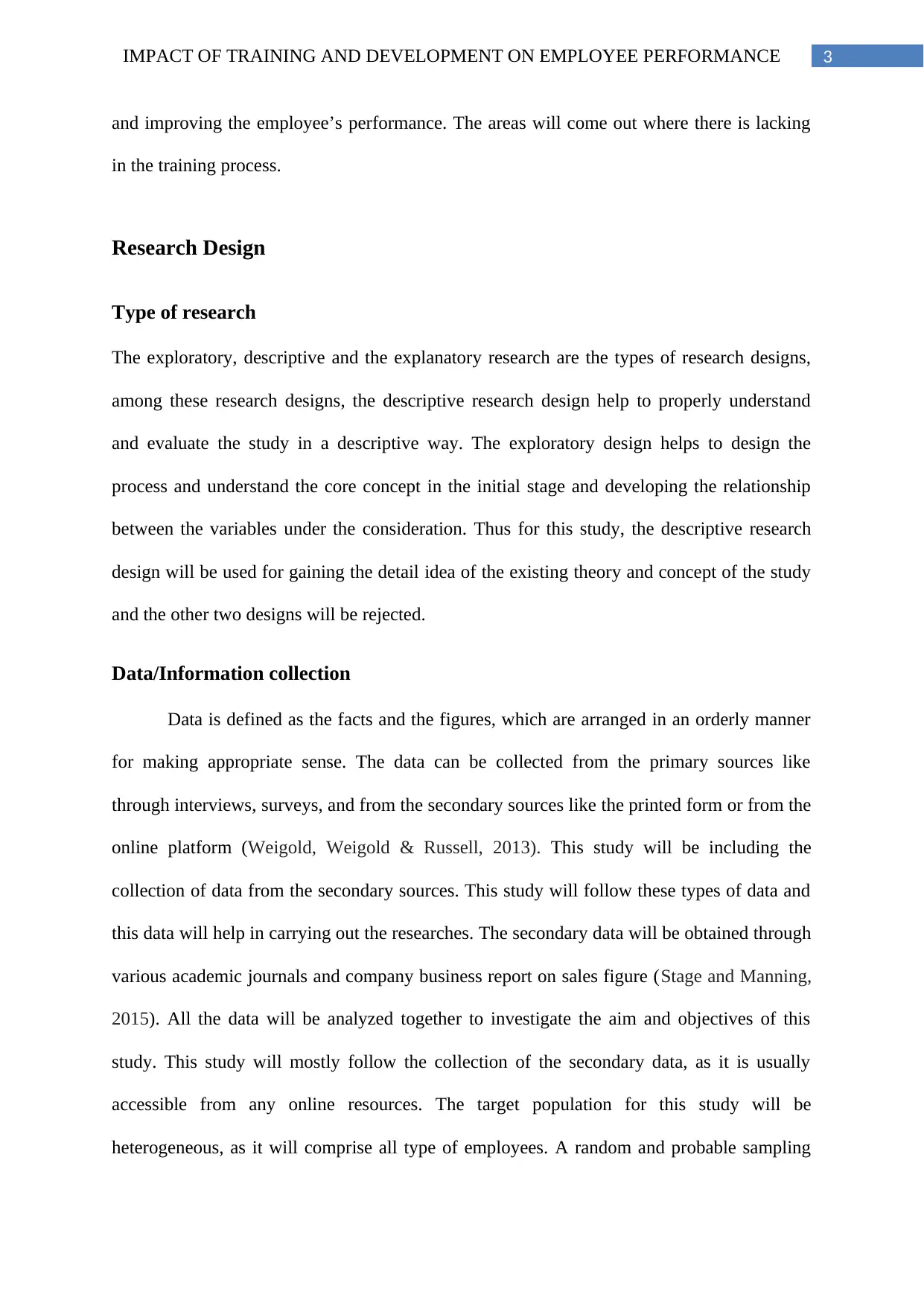
3IMPACT OF TRAINING AND DEVELOPMENT ON EMPLOYEE PERFORMANCE
and improving the employee’s performance. The areas will come out where there is lacking
in the training process.
Research Design
Type of research
The exploratory, descriptive and the explanatory research are the types of research designs,
among these research designs, the descriptive research design help to properly understand
and evaluate the study in a descriptive way. The exploratory design helps to design the
process and understand the core concept in the initial stage and developing the relationship
between the variables under the consideration. Thus for this study, the descriptive research
design will be used for gaining the detail idea of the existing theory and concept of the study
and the other two designs will be rejected.
Data/Information collection
Data is defined as the facts and the figures, which are arranged in an orderly manner
for making appropriate sense. The data can be collected from the primary sources like
through interviews, surveys, and from the secondary sources like the printed form or from the
online platform (Weigold, Weigold & Russell, 2013). This study will be including the
collection of data from the secondary sources. This study will follow these types of data and
this data will help in carrying out the researches. The secondary data will be obtained through
various academic journals and company business report on sales figure (Stage and Manning,
2015). All the data will be analyzed together to investigate the aim and objectives of this
study. This study will mostly follow the collection of the secondary data, as it is usually
accessible from any online resources. The target population for this study will be
heterogeneous, as it will comprise all type of employees. A random and probable sampling
and improving the employee’s performance. The areas will come out where there is lacking
in the training process.
Research Design
Type of research
The exploratory, descriptive and the explanatory research are the types of research designs,
among these research designs, the descriptive research design help to properly understand
and evaluate the study in a descriptive way. The exploratory design helps to design the
process and understand the core concept in the initial stage and developing the relationship
between the variables under the consideration. Thus for this study, the descriptive research
design will be used for gaining the detail idea of the existing theory and concept of the study
and the other two designs will be rejected.
Data/Information collection
Data is defined as the facts and the figures, which are arranged in an orderly manner
for making appropriate sense. The data can be collected from the primary sources like
through interviews, surveys, and from the secondary sources like the printed form or from the
online platform (Weigold, Weigold & Russell, 2013). This study will be including the
collection of data from the secondary sources. This study will follow these types of data and
this data will help in carrying out the researches. The secondary data will be obtained through
various academic journals and company business report on sales figure (Stage and Manning,
2015). All the data will be analyzed together to investigate the aim and objectives of this
study. This study will mostly follow the collection of the secondary data, as it is usually
accessible from any online resources. The target population for this study will be
heterogeneous, as it will comprise all type of employees. A random and probable sampling
Paraphrase This Document
Need a fresh take? Get an instant paraphrase of this document with our AI Paraphraser
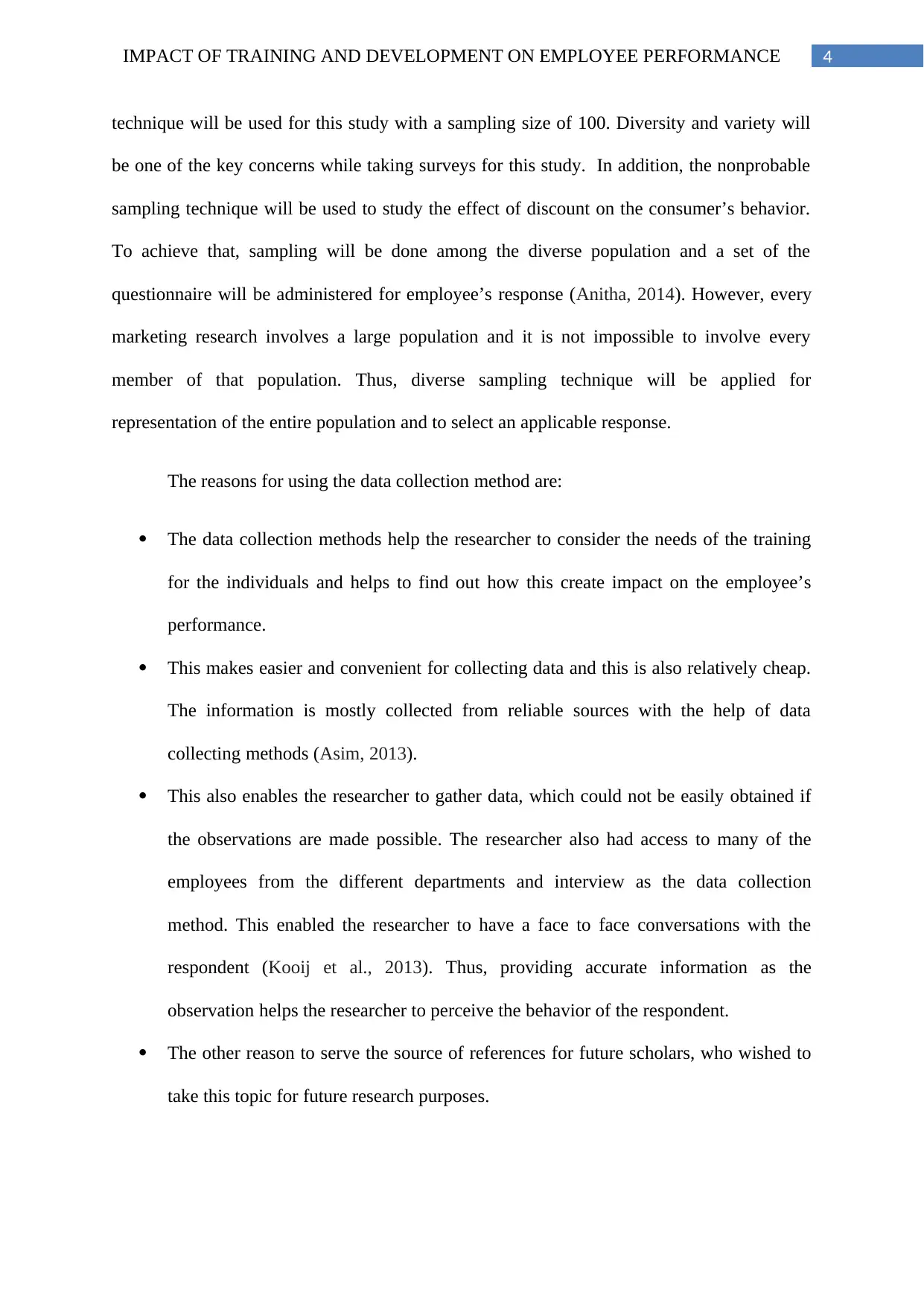
4IMPACT OF TRAINING AND DEVELOPMENT ON EMPLOYEE PERFORMANCE
technique will be used for this study with a sampling size of 100. Diversity and variety will
be one of the key concerns while taking surveys for this study. In addition, the nonprobable
sampling technique will be used to study the effect of discount on the consumer’s behavior.
To achieve that, sampling will be done among the diverse population and a set of the
questionnaire will be administered for employee’s response (Anitha, 2014). However, every
marketing research involves a large population and it is not impossible to involve every
member of that population. Thus, diverse sampling technique will be applied for
representation of the entire population and to select an applicable response.
The reasons for using the data collection method are:
The data collection methods help the researcher to consider the needs of the training
for the individuals and helps to find out how this create impact on the employee’s
performance.
This makes easier and convenient for collecting data and this is also relatively cheap.
The information is mostly collected from reliable sources with the help of data
collecting methods (Asim, 2013).
This also enables the researcher to gather data, which could not be easily obtained if
the observations are made possible. The researcher also had access to many of the
employees from the different departments and interview as the data collection
method. This enabled the researcher to have a face to face conversations with the
respondent (Kooij et al., 2013). Thus, providing accurate information as the
observation helps the researcher to perceive the behavior of the respondent.
The other reason to serve the source of references for future scholars, who wished to
take this topic for future research purposes.
technique will be used for this study with a sampling size of 100. Diversity and variety will
be one of the key concerns while taking surveys for this study. In addition, the nonprobable
sampling technique will be used to study the effect of discount on the consumer’s behavior.
To achieve that, sampling will be done among the diverse population and a set of the
questionnaire will be administered for employee’s response (Anitha, 2014). However, every
marketing research involves a large population and it is not impossible to involve every
member of that population. Thus, diverse sampling technique will be applied for
representation of the entire population and to select an applicable response.
The reasons for using the data collection method are:
The data collection methods help the researcher to consider the needs of the training
for the individuals and helps to find out how this create impact on the employee’s
performance.
This makes easier and convenient for collecting data and this is also relatively cheap.
The information is mostly collected from reliable sources with the help of data
collecting methods (Asim, 2013).
This also enables the researcher to gather data, which could not be easily obtained if
the observations are made possible. The researcher also had access to many of the
employees from the different departments and interview as the data collection
method. This enabled the researcher to have a face to face conversations with the
respondent (Kooij et al., 2013). Thus, providing accurate information as the
observation helps the researcher to perceive the behavior of the respondent.
The other reason to serve the source of references for future scholars, who wished to
take this topic for future research purposes.
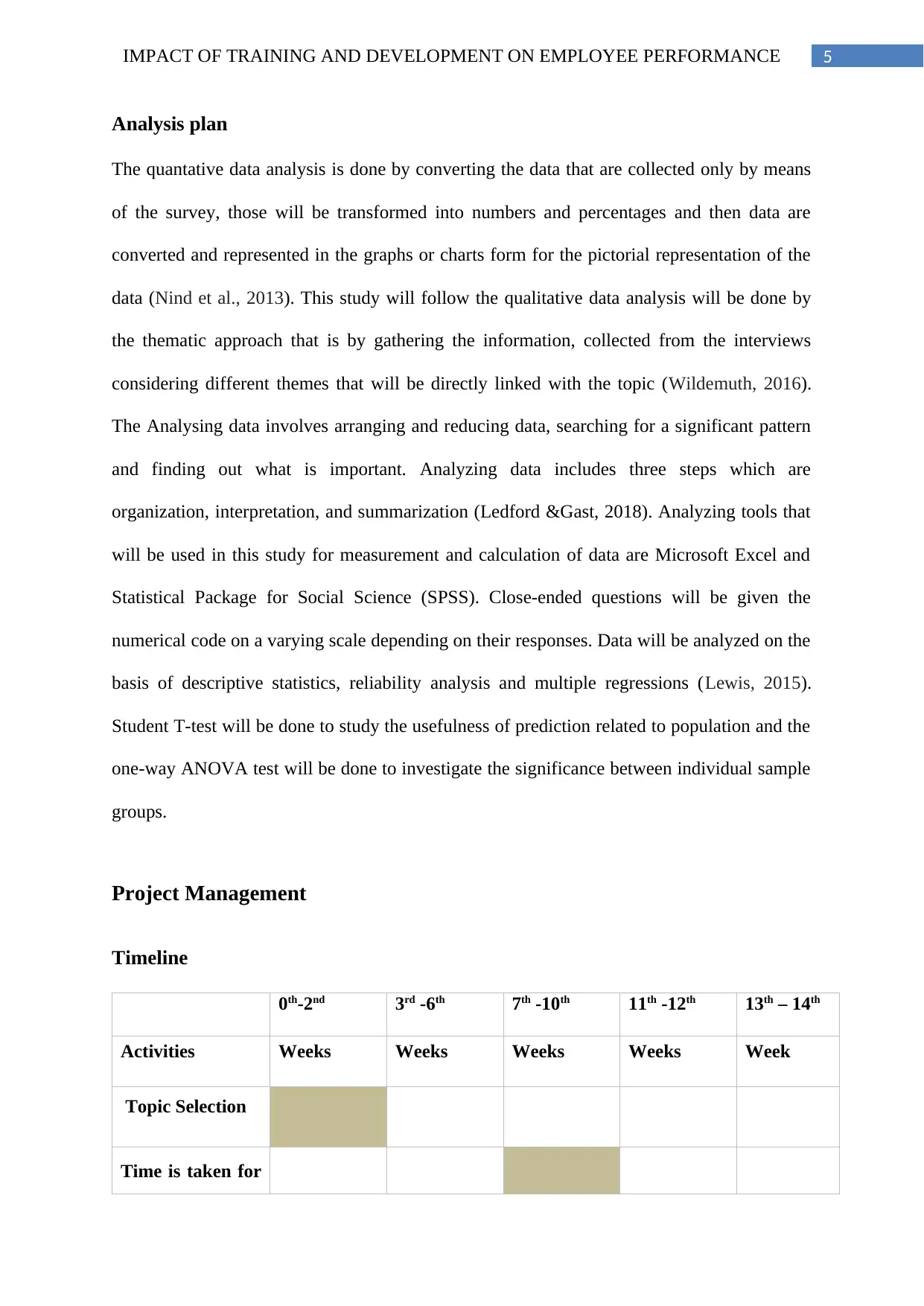
5IMPACT OF TRAINING AND DEVELOPMENT ON EMPLOYEE PERFORMANCE
Analysis plan
The quantative data analysis is done by converting the data that are collected only by means
of the survey, those will be transformed into numbers and percentages and then data are
converted and represented in the graphs or charts form for the pictorial representation of the
data (Nind et al., 2013). This study will follow the qualitative data analysis will be done by
the thematic approach that is by gathering the information, collected from the interviews
considering different themes that will be directly linked with the topic (Wildemuth, 2016).
The Analysing data involves arranging and reducing data, searching for a significant pattern
and finding out what is important. Analyzing data includes three steps which are
organization, interpretation, and summarization (Ledford &Gast, 2018). Analyzing tools that
will be used in this study for measurement and calculation of data are Microsoft Excel and
Statistical Package for Social Science (SPSS). Close-ended questions will be given the
numerical code on a varying scale depending on their responses. Data will be analyzed on the
basis of descriptive statistics, reliability analysis and multiple regressions (Lewis, 2015).
Student T-test will be done to study the usefulness of prediction related to population and the
one-way ANOVA test will be done to investigate the significance between individual sample
groups.
Project Management
Timeline
0th-2nd 3rd -6th 7th -10th 11th -12th 13th – 14th
Activities Weeks Weeks Weeks Weeks Week
Topic Selection
Time is taken for
Analysis plan
The quantative data analysis is done by converting the data that are collected only by means
of the survey, those will be transformed into numbers and percentages and then data are
converted and represented in the graphs or charts form for the pictorial representation of the
data (Nind et al., 2013). This study will follow the qualitative data analysis will be done by
the thematic approach that is by gathering the information, collected from the interviews
considering different themes that will be directly linked with the topic (Wildemuth, 2016).
The Analysing data involves arranging and reducing data, searching for a significant pattern
and finding out what is important. Analyzing data includes three steps which are
organization, interpretation, and summarization (Ledford &Gast, 2018). Analyzing tools that
will be used in this study for measurement and calculation of data are Microsoft Excel and
Statistical Package for Social Science (SPSS). Close-ended questions will be given the
numerical code on a varying scale depending on their responses. Data will be analyzed on the
basis of descriptive statistics, reliability analysis and multiple regressions (Lewis, 2015).
Student T-test will be done to study the usefulness of prediction related to population and the
one-way ANOVA test will be done to investigate the significance between individual sample
groups.
Project Management
Timeline
0th-2nd 3rd -6th 7th -10th 11th -12th 13th – 14th
Activities Weeks Weeks Weeks Weeks Week
Topic Selection
Time is taken for
⊘ This is a preview!⊘
Do you want full access?
Subscribe today to unlock all pages.

Trusted by 1+ million students worldwide
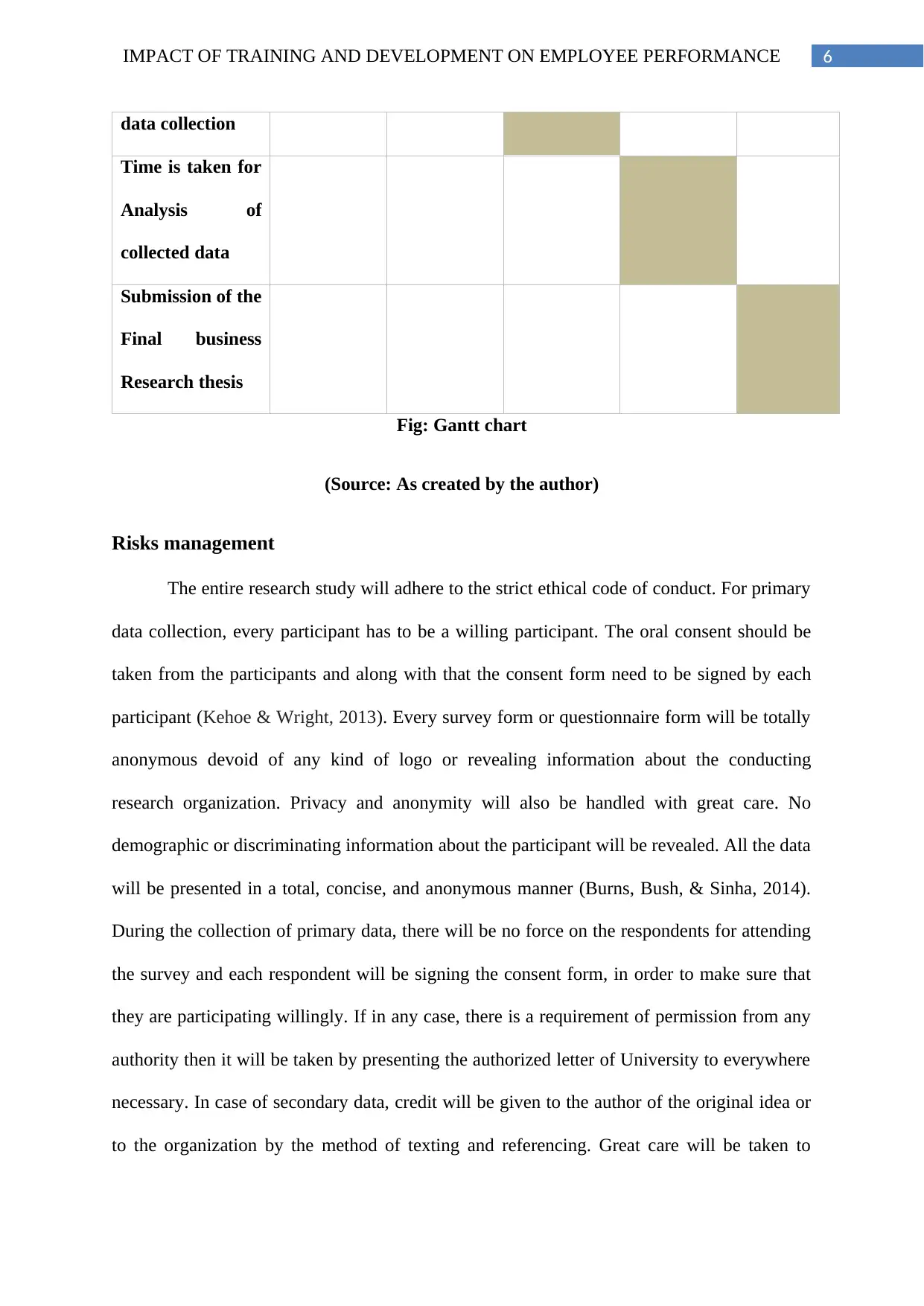
6IMPACT OF TRAINING AND DEVELOPMENT ON EMPLOYEE PERFORMANCE
data collection
Time is taken for
Analysis of
collected data
Submission of the
Final business
Research thesis
Fig: Gantt chart
(Source: As created by the author)
Risks management
The entire research study will adhere to the strict ethical code of conduct. For primary
data collection, every participant has to be a willing participant. The oral consent should be
taken from the participants and along with that the consent form need to be signed by each
participant (Kehoe & Wright, 2013). Every survey form or questionnaire form will be totally
anonymous devoid of any kind of logo or revealing information about the conducting
research organization. Privacy and anonymity will also be handled with great care. No
demographic or discriminating information about the participant will be revealed. All the data
will be presented in a total, concise, and anonymous manner (Burns, Bush, & Sinha, 2014).
During the collection of primary data, there will be no force on the respondents for attending
the survey and each respondent will be signing the consent form, in order to make sure that
they are participating willingly. If in any case, there is a requirement of permission from any
authority then it will be taken by presenting the authorized letter of University to everywhere
necessary. In case of secondary data, credit will be given to the author of the original idea or
to the organization by the method of texting and referencing. Great care will be taken to
data collection
Time is taken for
Analysis of
collected data
Submission of the
Final business
Research thesis
Fig: Gantt chart
(Source: As created by the author)
Risks management
The entire research study will adhere to the strict ethical code of conduct. For primary
data collection, every participant has to be a willing participant. The oral consent should be
taken from the participants and along with that the consent form need to be signed by each
participant (Kehoe & Wright, 2013). Every survey form or questionnaire form will be totally
anonymous devoid of any kind of logo or revealing information about the conducting
research organization. Privacy and anonymity will also be handled with great care. No
demographic or discriminating information about the participant will be revealed. All the data
will be presented in a total, concise, and anonymous manner (Burns, Bush, & Sinha, 2014).
During the collection of primary data, there will be no force on the respondents for attending
the survey and each respondent will be signing the consent form, in order to make sure that
they are participating willingly. If in any case, there is a requirement of permission from any
authority then it will be taken by presenting the authorized letter of University to everywhere
necessary. In case of secondary data, credit will be given to the author of the original idea or
to the organization by the method of texting and referencing. Great care will be taken to
Paraphrase This Document
Need a fresh take? Get an instant paraphrase of this document with our AI Paraphraser
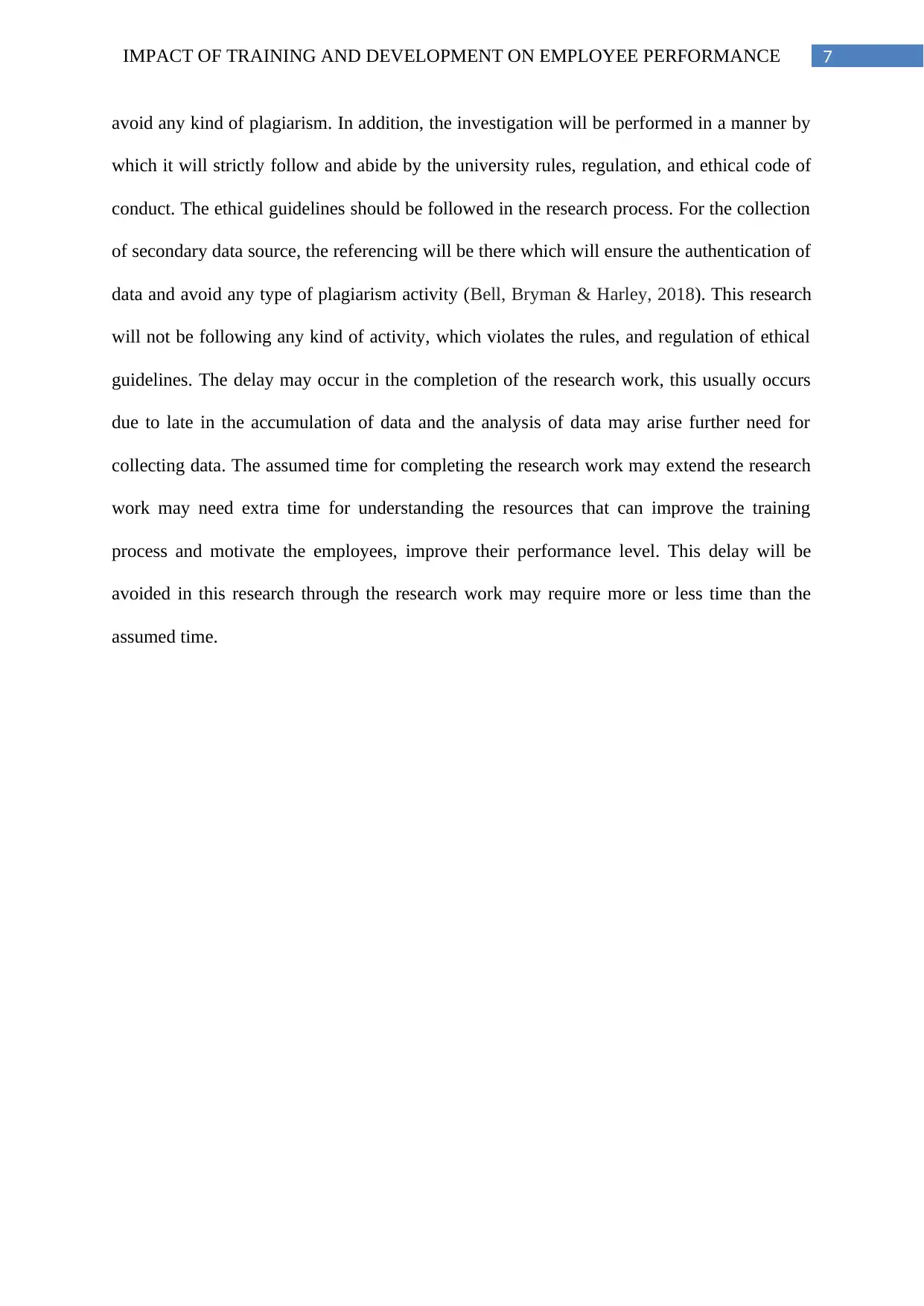
7IMPACT OF TRAINING AND DEVELOPMENT ON EMPLOYEE PERFORMANCE
avoid any kind of plagiarism. In addition, the investigation will be performed in a manner by
which it will strictly follow and abide by the university rules, regulation, and ethical code of
conduct. The ethical guidelines should be followed in the research process. For the collection
of secondary data source, the referencing will be there which will ensure the authentication of
data and avoid any type of plagiarism activity (Bell, Bryman & Harley, 2018). This research
will not be following any kind of activity, which violates the rules, and regulation of ethical
guidelines. The delay may occur in the completion of the research work, this usually occurs
due to late in the accumulation of data and the analysis of data may arise further need for
collecting data. The assumed time for completing the research work may extend the research
work may need extra time for understanding the resources that can improve the training
process and motivate the employees, improve their performance level. This delay will be
avoided in this research through the research work may require more or less time than the
assumed time.
avoid any kind of plagiarism. In addition, the investigation will be performed in a manner by
which it will strictly follow and abide by the university rules, regulation, and ethical code of
conduct. The ethical guidelines should be followed in the research process. For the collection
of secondary data source, the referencing will be there which will ensure the authentication of
data and avoid any type of plagiarism activity (Bell, Bryman & Harley, 2018). This research
will not be following any kind of activity, which violates the rules, and regulation of ethical
guidelines. The delay may occur in the completion of the research work, this usually occurs
due to late in the accumulation of data and the analysis of data may arise further need for
collecting data. The assumed time for completing the research work may extend the research
work may need extra time for understanding the resources that can improve the training
process and motivate the employees, improve their performance level. This delay will be
avoided in this research through the research work may require more or less time than the
assumed time.
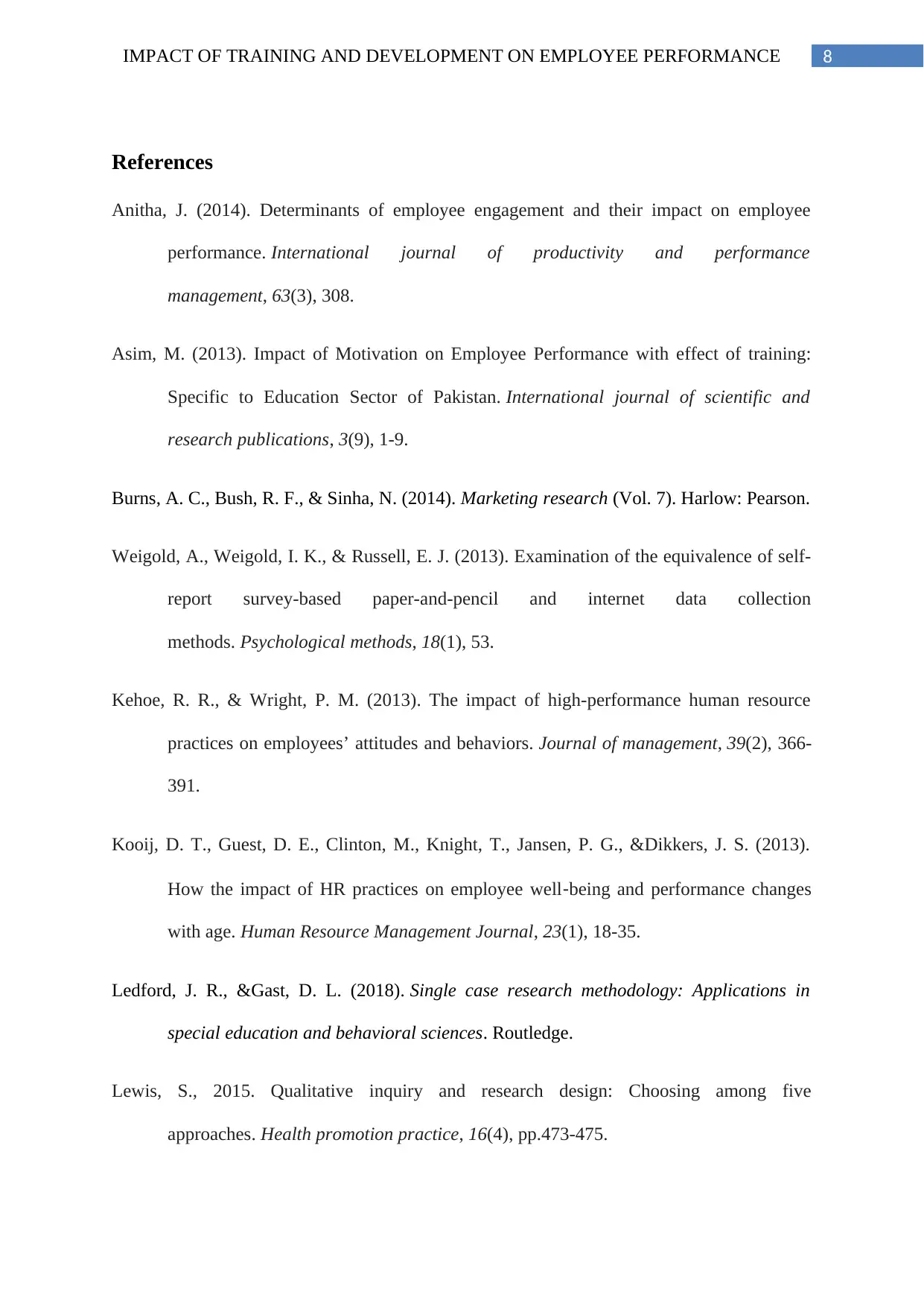
8IMPACT OF TRAINING AND DEVELOPMENT ON EMPLOYEE PERFORMANCE
References
Anitha, J. (2014). Determinants of employee engagement and their impact on employee
performance. International journal of productivity and performance
management, 63(3), 308.
Asim, M. (2013). Impact of Motivation on Employee Performance with effect of training:
Specific to Education Sector of Pakistan. International journal of scientific and
research publications, 3(9), 1-9.
Burns, A. C., Bush, R. F., & Sinha, N. (2014). Marketing research (Vol. 7). Harlow: Pearson.
Weigold, A., Weigold, I. K., & Russell, E. J. (2013). Examination of the equivalence of self-
report survey-based paper-and-pencil and internet data collection
methods. Psychological methods, 18(1), 53.
Kehoe, R. R., & Wright, P. M. (2013). The impact of high-performance human resource
practices on employees’ attitudes and behaviors. Journal of management, 39(2), 366-
391.
Kooij, D. T., Guest, D. E., Clinton, M., Knight, T., Jansen, P. G., &Dikkers, J. S. (2013).
How the impact of HR practices on employee well‐being and performance changes
with age. Human Resource Management Journal, 23(1), 18-35.
Ledford, J. R., &Gast, D. L. (2018). Single case research methodology: Applications in
special education and behavioral sciences. Routledge.
Lewis, S., 2015. Qualitative inquiry and research design: Choosing among five
approaches. Health promotion practice, 16(4), pp.473-475.
References
Anitha, J. (2014). Determinants of employee engagement and their impact on employee
performance. International journal of productivity and performance
management, 63(3), 308.
Asim, M. (2013). Impact of Motivation on Employee Performance with effect of training:
Specific to Education Sector of Pakistan. International journal of scientific and
research publications, 3(9), 1-9.
Burns, A. C., Bush, R. F., & Sinha, N. (2014). Marketing research (Vol. 7). Harlow: Pearson.
Weigold, A., Weigold, I. K., & Russell, E. J. (2013). Examination of the equivalence of self-
report survey-based paper-and-pencil and internet data collection
methods. Psychological methods, 18(1), 53.
Kehoe, R. R., & Wright, P. M. (2013). The impact of high-performance human resource
practices on employees’ attitudes and behaviors. Journal of management, 39(2), 366-
391.
Kooij, D. T., Guest, D. E., Clinton, M., Knight, T., Jansen, P. G., &Dikkers, J. S. (2013).
How the impact of HR practices on employee well‐being and performance changes
with age. Human Resource Management Journal, 23(1), 18-35.
Ledford, J. R., &Gast, D. L. (2018). Single case research methodology: Applications in
special education and behavioral sciences. Routledge.
Lewis, S., 2015. Qualitative inquiry and research design: Choosing among five
approaches. Health promotion practice, 16(4), pp.473-475.
⊘ This is a preview!⊘
Do you want full access?
Subscribe today to unlock all pages.

Trusted by 1+ million students worldwide
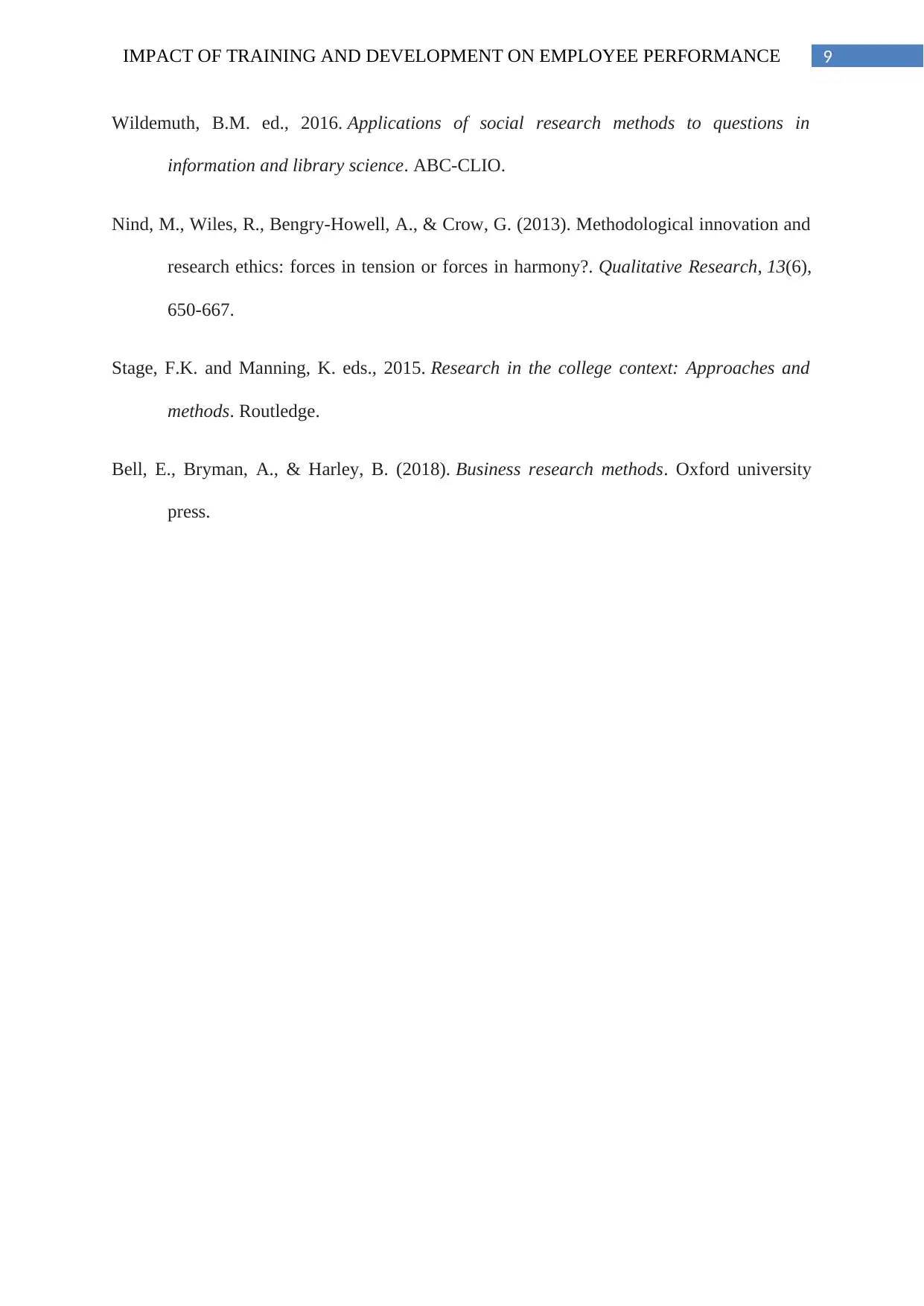
9IMPACT OF TRAINING AND DEVELOPMENT ON EMPLOYEE PERFORMANCE
Wildemuth, B.M. ed., 2016. Applications of social research methods to questions in
information and library science. ABC-CLIO.
Nind, M., Wiles, R., Bengry-Howell, A., & Crow, G. (2013). Methodological innovation and
research ethics: forces in tension or forces in harmony?. Qualitative Research, 13(6),
650-667.
Stage, F.K. and Manning, K. eds., 2015. Research in the college context: Approaches and
methods. Routledge.
Bell, E., Bryman, A., & Harley, B. (2018). Business research methods. Oxford university
press.
Wildemuth, B.M. ed., 2016. Applications of social research methods to questions in
information and library science. ABC-CLIO.
Nind, M., Wiles, R., Bengry-Howell, A., & Crow, G. (2013). Methodological innovation and
research ethics: forces in tension or forces in harmony?. Qualitative Research, 13(6),
650-667.
Stage, F.K. and Manning, K. eds., 2015. Research in the college context: Approaches and
methods. Routledge.
Bell, E., Bryman, A., & Harley, B. (2018). Business research methods. Oxford university
press.
1 out of 10
Related Documents
Your All-in-One AI-Powered Toolkit for Academic Success.
+13062052269
info@desklib.com
Available 24*7 on WhatsApp / Email
![[object Object]](/_next/static/media/star-bottom.7253800d.svg)
Unlock your academic potential
Copyright © 2020–2025 A2Z Services. All Rights Reserved. Developed and managed by ZUCOL.





